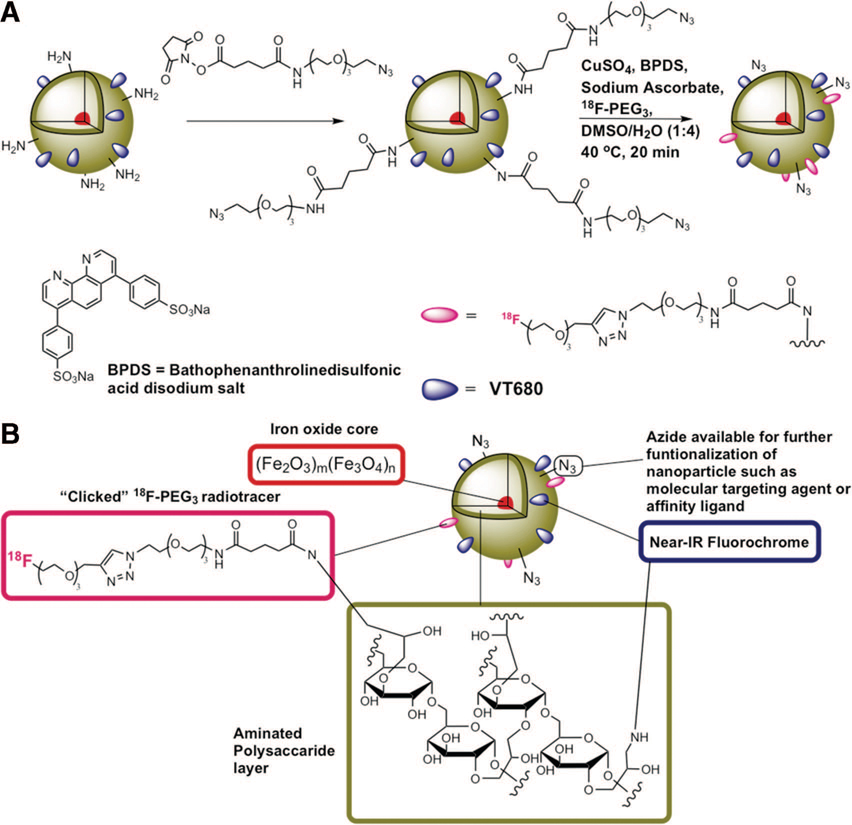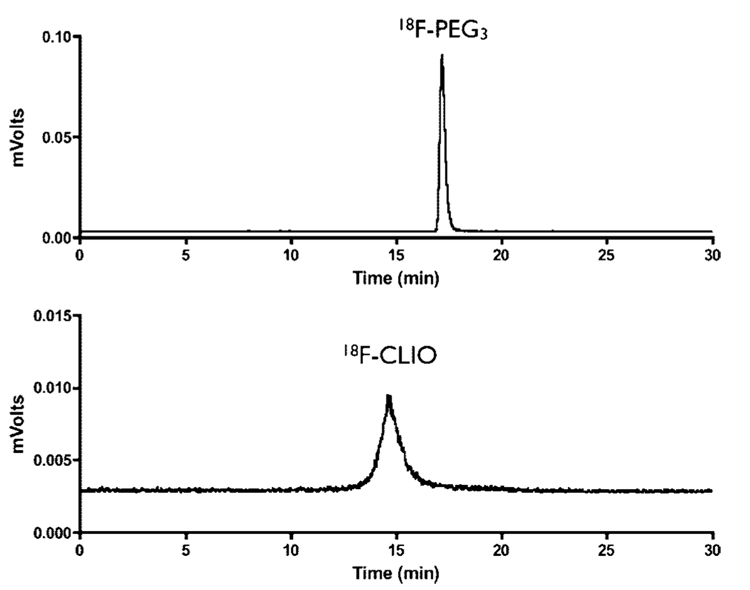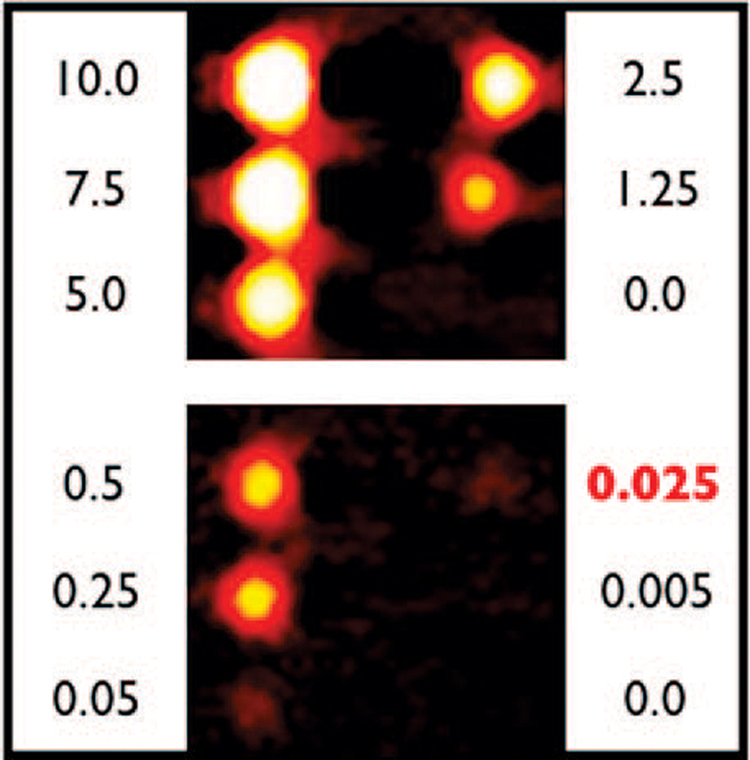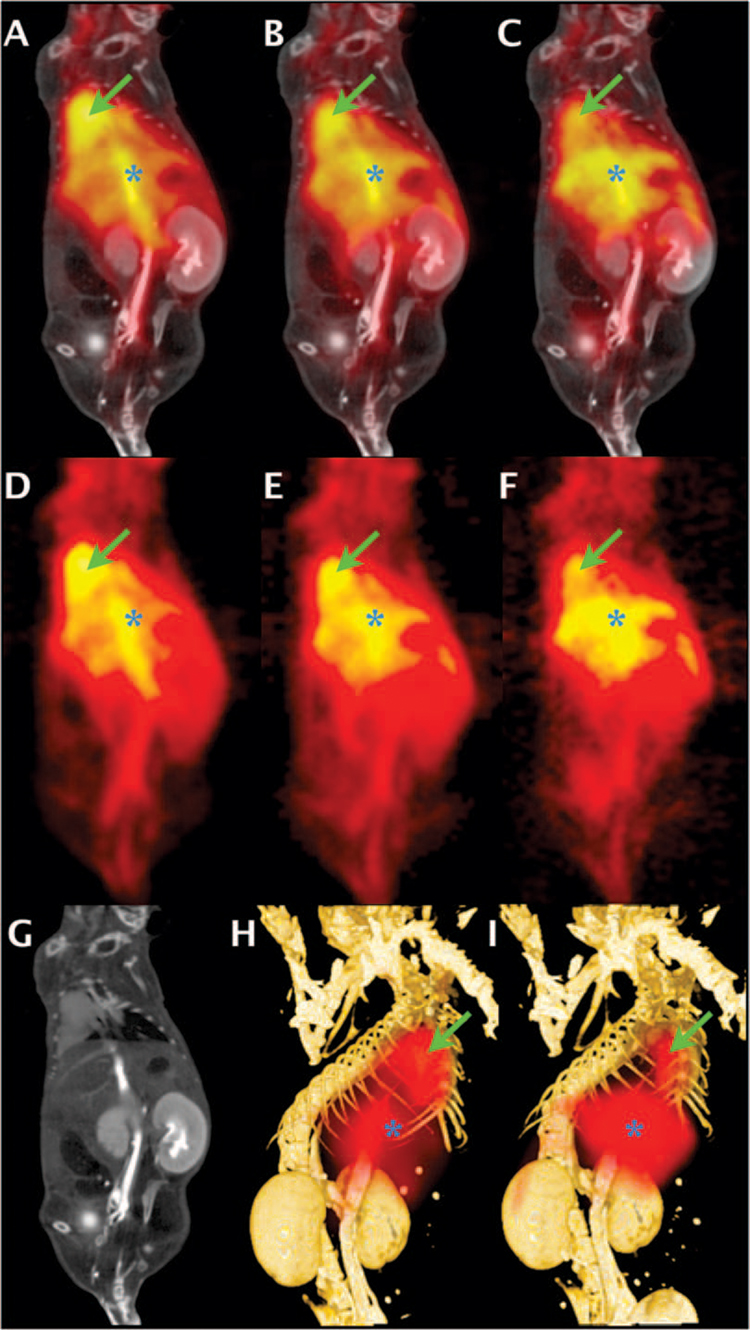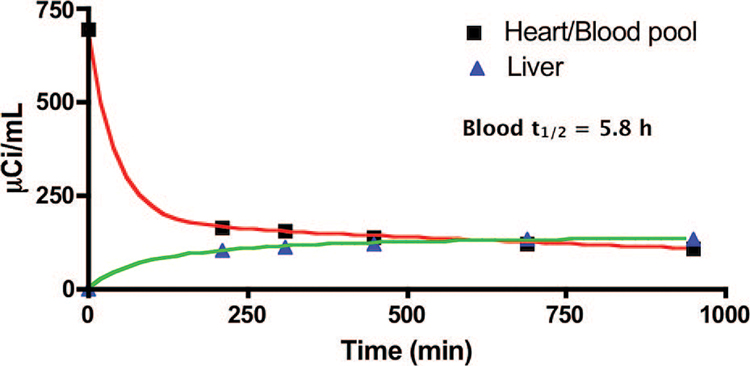Abstract
We report the synthesis and in vivo characterization of an 18F modified trimodal nanoparticle (18F-CLIO). This particle consists of cross-linked dextran held together in core–shell formation by a superparamagnetic iron oxide core and functionalized with the radionuclide 18F in high yield via “click” chemistry. The particle can be detected with positron emission tomography, fluorescence molecular tomography, and magnetic resonance imaging. The presence of 18F dramatically lowers the detection threshold of the nanoparticles, while the facile conjugation chemistry provides a simple platform for rapid and efficient nanoparticle labeling.
INTRODUCTION
Polymer-coated metal core nanoparticles have emerged as important platforms for a variety of biological applications such as bioseparation, sensing, molecular imaging, and drug delivery. Examples of such materials include carbohydrate-coated iron oxide nanoparticles (1–3) for magnetic applications, synthetic polymer coated cores for molecular imaging (4, 5), gold nanoshells for therapy, or biocompatible quantum dots (6, 7). Magnetic nanoparticles, in particular, have received much attention, as they were shown to be biocompatible (8) and have low clinical toxicity (9), and subsequently were among the first nanomaterials tested in clinical trials (10). While native carbohydrate-coated preparations primarily target macrophages, monocytes, and other phagocytic cells in vivo, conjugation of affinity ligands has been used to image other molecular targets in vivo (11, 12). We have recently shown that small molecule modifications (13) can yield uniquely targeted nanoparticles with low toxicities (14). Despite these advances, the in vivo detection threshold of nanoparticles via magnetic resonance is generally in the micromolar range requiring an estimated ~200–700 mg (Fe) for a 70 Kg patient.
One avenue to substantially decrease the detection threshold and therefore the clinical dose is to label nanoparticles with positron emitters and detect them by position emission tomography (PET) imaging. Recently, we reported the use of a 64Cu labeled trireporting nanoparticle that could be used at ~100 times lower doses for PET imaging as compared to MRI and was employed to image macrophages in inflammatory atherosclerotic plaques (15). This material was based on aminated cross-linked dextran iron oxide (CLIO) decorated with diethylene triamine pentaacetic acid (DTPA) to transchelate 64Cu. While we showed proof of principle, 64Cu is not widely available, complicating clinical day-to-day on-demand syntheses. On the contrary, 18F is a widely available PET isotope that is produced daily in cyclotrons of most major hospitals and distribution centers. 18F has additional advantages over 64Cu such as higher sensitivity, shorter half-life, and the ability of irreversible covalent bonding. Despite these advantages, the addition of 18F to functionally complex materials is chemically challenging and is a major reason for the absence of reports of 18F iron nanoparticles. Here, we report a facile and straightforward synthesis method for an 18F trimodal nanoparticle (18F-CLIO, Figure 1) and demonstrate its use for in vivo PET imaging. In this work, we have used “click” chemistry (16, 17), the copper-catalyzed azide–alkyne cycloaddition, to introduce 18F onto an azide-modified nanoparticle.
Figure 1.
Preparation of 18F-CLIO. (A) Derivatization of primary amines on CLIO-VT680 with the NHS ester of 1-azido-13-oxo-3,6,9-trioxa-12-azaheptadecan-17-oic acid followed by chemoselective “click” of 18F-PEG3 radiotracer. (B) Schematic of 18F-CLIO.
The introduction of 18F to functionally complex molecules has been an outstanding problem in nuclear chemistry. Though there are many reported conjugation methods, most suffer from the requirement of harsh coupling conditions, long reactions times, multistep protocols, or poor overall yields. A number of 18F labeling methods have been described and are conceivable for nanoparticle labeling. One such method, nucleophilic aromatic substitution, used to prepare N-succinimidyl 4-[18F]fluorobenzoate and 4-[18F]fluorobenzaldehyde, either requires multiple steps post-labeling to obtain an amine-reactive species for the former or produces a volatile compound difficult to concentrate for subsequent bimolecular reactions in the case of the latter (18, 19). In contrast, “click” chemistry, specifically copper-catalyzed azide–alkyne cycloaddition, has proven to be an extremely robust, mild, conceptually simple, and chemise-lective method to conjugate function to complex macromolecules and biomolecules. Recently, there have been a variety of reports demonstrating that the “click” reaction can be used efficiently and mildly to conjugate an 18F label to a variety of peptides and small molecules (20, 21). These reports motivated us to explore the application of “click” chemistry to modify nanoparticles with 18F.
MATERIALS AND METHODS
Materials
All reagents were purchased from from Sigma-Aldrich and used without further purification unless otherwise noted. 1-Amino-11-azido-3,6,9-trioxaundecane was purchased from Toronto Research Chemicals and used as received. Sodium [18F]-fluoride (Na[18F]F) in 18O -enriched water was purchased from PETNET (Woburn, MA). The well-characterized nanoparticle MION (MGH-CMIR, Charlestown, MA) served as starting material (2). The dextran coating of the nanoparticle was cross-linked with epichlorin hydrin, aminated, and labeled with near-infrared fluorochrome Vivotag-680 (VT680, VisEn Medical, Woburn, MA) (22). The ratio of VT680 per nanoparticle was approximately 5 dye moieties/particle. Preparative-scale high-performance liquid chromatography (HPLC) purification was achieved using a Machery-Nagel Nucleodur C18 Pyramid 250 × 10 mm Vario-Prep column (60:40 0.1% trifluoroacetic acid (v/v) in water–acetonitrile (AcCN) at 5.5 mL.min−1) with a 254 nm UV detector and radiodetector connected in series. Analytical HPLC was performed employing a Grace VYDAC (218TP510) C18 reversed-phase column (eluents 0.1% TFA (v/v) in water and AcCN; gradient: 0–17 min, 5–60% B; 17–21 min, 60–95% B; 21–24 min, 95% B; 24–25 min, 95–5% B; 25–30 min, 5% B; 2 mL.min−1) with a dual-wavelength UV–vis detector and a flow-through gamma detector connected in series. HyperSep C18 cartridges were purchased from Thermo Electron (Bellefonte, PA) and Sep-pak VAC Alumina-N cartridges from Waters (Milford, MA).
Synthesis of 18F-PEG3
The preparation of the 2-(2-(2-(prop-2-ynyloxy)ethoxy)ethoxy)ethyl tosylate (20) precursor started from the monopotassium salt of triethylene glycol, which was alkylated with propargyl bromide. This propargyl PEG3 was treated with tosyl chloride in the presence of triethyl amine. 3-(2-(2-(2-[18F]-Fluoroethoxy)-ethoxy)ethoxy)prop-1-yne (18F-PEG3) was prepared using Synthra RN Plus automated synthesizer (Synthra GmbH, Hamburg, Germany) operated by Explora View software in an average time of 40 min. The target well was charged with Na[18F]F, n.c.a., (~1850 MBq, 50 mCi) in H218O (150 µL), 150 µL of a 74 mM K2CO3 solution in water, and 250 µL of 49 mM Kryptofix 2.2.2 in AcCN. The synthesizer reagent vials were filled as follows: A2 with AcCN (350 µL), A3 with tosylate 2 (1.0 mg, 19.2 µmol) in DMSO (400 µL), A5 with DMSO (50 µL), and B2 with H2O (900 µL). The Na[18F]F/K2CO3/K2.2.2 solution was transferred to Reaction Vessel #1 and dried by azeotropic distillation of the acetonitrile/water solution by heating to 60 °C under reduced pressure and a flow of argon to achieve ~310 mbar for 2 min followed by 98 °C and 270 mbar for 3 min. Reaction Vessel #1 was cooled to 50 °C, tosylate 2 in DMSO (400 µL) added, and the reaction vessel pressurized to 2000 mbar and heated to 110 °C for 15 min. After cooling to 30 °C, the mixture was filtered through an Alumina-N cartridge (100 mg, 1 mL, Waters) into Reaction Vessel #2. The Alumina-N cartridge was washed with DMSO (50 µL), and the combined filtrates were diluted with water (900 µL). This solution was subjected to preparative HPLC purification. 18F-PEG3 was collected (tR = 4.9 min) in 3–4 mL of solvent and isolated by C18 solid-phase extraction. Elution of the collected material with CH2Cl2 (600 µL) to give 18F-PEG3 in 57% average decay-corrected radiochemical yield (RCY). Analytical HPLC demonstrated >99% radiochemical purity of 18F-PEG3, Figure 2.
Figure 2.
HPLC analysis of purified 18F-PEG3 and 18F-CLIO demonstrating >98% purity.
Preparation of Azido-PEG Modified CLIO
1-Amino-11-azido-3,6,9-trioxaundecane (218 mg, 1 mmol) and glutaric anhydride (114 mg, 1 mmol) were dissolved in 1 mL methylene chloride and refluxed for 1 h. Evaporation of solvent yielded 1-azido-13-oxo-3,6,9-trioxa-12-azaheptadecan-17-oic acid quantitatively, verified by LRMS-ESI [M + H]+ m/z calc. [C13H25N4O6]+ 333.17, found 333.3. The azido–acid (33 mg, 0.1 mmol) was stirred for 3 h in 0.3 mL AcCN with 8 µL of pyridine and 26 mg of disuccinimidylcarbonate. The AcCN was evaporated, and the resulting crude N-hydroxysuccinimide ester was used directly with amine-terminated iron oxide nanoparticles. The aminated cross-linked dextran iron oxide (CLIO) nanoparticle was prepared as previously described (23). Nanoparticles were approximately 30 nm in diameter and contained on average 40 primary amines. Aminated CLIO was functionalized first with NHS modified VT680 (VisEn Medical, Woburn, MA) such that there were approximately 5 molecules of VT680 per particle. The remaining amines were capped with the NHS ester of 1-azido-13-oxo-3,6,9-trioxa-12-azaheptadecan-17-oic acid to give the CLIO-azide. In a typical coupling procedure, 0.4 mg of amine-terminated CLIO was dissolved in 0.5 mL of 0.1 M sodium bicarbonate buffered to a pH of 8.5. To this solution was added 40 µL of DMSO containing 1 mg of the azido N-hydroxysuccinimide ester. The solution was stirred at room temperature for 2 h, purified by centrifuge filtration, and stored in PBS buffered to pH 7.4.
Conjugation
18F-PEG3 in 50–100 µL water added to the azido-CLIO (50 µL of a 400 µg/100 µL 1×PBS (phosphate buffered solution)) was subjected to water-soluble copper-catalyzed 1,3-dipolar cycloaddition reaction conditions: 40 µL 10 mM Cu(II)SO4/bathophenanthrolinedisulfonic acid disodium salt (BPDS) in distilled water/DMSO (3:1) and 40 uL 100 mM Na-ascorbate in distilled water (24). The reaction mixture was incubated for 40 min at 40 °C and filtered to remove the 18F-CLIO from unreacted 18F-PEG3. 18F-CLIO was washed with 1×PBS until no activity was collected in the filtrate (>1 µCi). HPLC analysis demonstrated >99% radiochemical purity of 18F-CLIO (Figure 2). The 18F-labeled nanoparticle was suspended in DPBS (Dulbecco‘s phosphate buffered solution with Ca2+ and Mg2+).
Phantom Experiment
To compare the sensitivity of nanoparticle detection with MRI and PET, 18F-CLIO was diluted in 2% low melting agarose to concentrations ranging from 0.005 to 10 µg Fe /mL and added to wells in a precast gel. PET-CT imaging of 2 gels was followed by MRI using a 7 T Pharmascan magnet (Bruker, Billerica, MA) and employing a T2* weighted gradient echo sequence (TE 140 ms, matrix 128 × 128, FOV 60 × 40 mm2, slice thickness 0.8 mm).
Mice
Inbred male BALB/c (B/c, H-2d) mice (8–12 weeks old) were obtained from Jackson Laboratory (Bar Harbor, ME). The mice were maintained at the animal facilities of Massachusetts General Hospital, accredited by the American Association of Laboratory Animal Care. All experiments conformed to animal care protocols approved by the institutional review board.
PET Imaging
Mice were imaged with PET-CT one hour after injection of 998 ± 74 µCi of 18F -CLIO (n = 6). This concentration was about 1 order of magnitude lower than previously used for MRI (10–20 mg Fe/kg). PET-CT was performed on an Inveon system (Siemens Preclinical Solutions). PET scans were terminated after 600 million events were recorded, with a typical acquisition time of 45 min. Spatial resolution of PET imaging approximated 1 mm isotropic. Acquisition coincidence data were rebinned using Fourier rebinning in 3D, and the resulting sinogram was reconstructed using an ordered subsets expectation maximization (OSEM) algorithm. For quantification of standard uptake values (SUV), images were reconstructed using 2D filtered back projection (FBP). The CT X-ray source was used with a power of 80 kVp and 500 µA and an exposure time of 370–400 ms. The effective 3D resolution was 90 µm isotropic. Typically, 360 projections were acquired. The reconstruction protocol was set to interpolate bilinearly, used a Shepp-Logan filter, and signal intensity was scaled to Hounsfield units. To achieve appropriate intravascular contrast, iopamidol 61% (Bracco Diagnostics, Princeton, NJ) was continuously infused via tail vein at a rate of 65 µL/min for the time of CT acquisition, which was approximately 7 min. Fused images were converted into DICOM format and analyzed using OsiriX shareware (Geneva, Switzerland, www.osirix-viewer.com) by placing volumes of interest in the various organs for calculation of target-to-background ratios. Standard uptake values (SUV) were calculated as (tissue activity/volume of tissue)/(body activity/body weight).
Pharmacokinetic Analysis
Blood half-life data obtained from the heart (blood pool organ) were fit to a biexponential model, and the half-life is reported as the weighted average of the distribution and clearance phases. For fitting permeability surface area product (PS/V) values, the average concentration of activity (decay corrected) in a region of interest determined by CT was measured for the time series. The interstitial concentration was obtained by subtracting the blood contribution using the plasma fraction for each organ. Assuming an interstitial void fraction of 0.05 for these particles, PS/V was fit using the plasma clearance and specific organ data. Due to the early imaging sequence with 18F, clearance was assumed to be negligible for all organs (uptake only) except the lung. The lung had similar low levels of activity as the kidney but demonstrated decreasing signal at later time points. Here, a value for lymphatic clearance was assumed to obtain a reasonable fit.
RESULTS
3-(2-(2-(2-[18F]-Fluoroethoxy)ethoxy)ethoxy)prop-1-yne (18F-PEG3) was prepared in 57% average decay-corrected radio-chemical yield from an alkynyl tosylate (see Supporting Information for full experimental details). 18F-PEG3 is prepared in one step and when compared with 4-[18F]fluorobenzaldehyde is relatively nonvolatile. This quality allows concentration of 18F-PEG3 to almost dryness, thus increasing the yield of the bimolecular second step. “Click” reaction with an azide-terminated CLIO yielded 18F-CLIO with a decay-corrected yield of 58%. Both 18F-PEG3 and 18F-CLIO were analyzed by HPLC to determine radiochemical purity. Following preparative HPLC purification of 18F-PEG3 and microcentrifuge filtration of 18F-CLIO, both were observed to be >98% pure (Figure 2). Average total 18F-CLIO synthesis time was 120 min from the start of radiolabeling of 18F-PEG3. 18F-CLIO had an average specific activity of 1.1 mCi/0.1 mg of nanoparticles. Control experiments using nanoparticles without azides or the absence of the copper catalyst failed in demonstrating the chemoselectivity of the conjugation.
The detection threshold of 18F-CLIO suspended in the agar phantom was 0.025 µg Fe/mL for PET-CT imaging, approximately 200 times lower than by T2*-weighted MR imaging (Figure 3). This is an improvement from 64Cu-labeled nanoparticles of comparable specific activity. The increased sensitivity was expected due to the increased branching ratio for the decay of 18F over 64Cu (25). As previously determined, the lowest observed concentration of the nanoparticles by MRI was 5 µg Fe/mL (15), demonstrating a PET detection threshold 200 times more sensitive than MRI at current specific activities. It is expected that optimization of reaction yields will further decrease the PET detection threshold.
Figure 3.
PET imaging of 2 agar phantoms with decreasing concentrations of 18F-CLIO (µg Fe/mL).
Purified 18F-CLIO was injected into the tail vein of 3 mice, and dynamic PET imaging was performed to determine organ biodistribution and blood clearance over time. Figure 4 summarizes one imaging series in which data were collected over the course of 16 h after intravenous injection of 18F-CLIO and shows images acquired at 2, 7, and 16 h. Initially, high sustained activity was detected in the blood pool, demonstrated by high PET signal in the cardiac chambers. Over time, this signal declined, while an increase of activity was observed in the liver and spleen. Using compartmental analysis, the uptake rate in the liver was much higher than uptake by the kidney (~4-fold, Table 1), and some of the renal activity may have indeed been due to the close proximity of the region of interest to the liver. The low renal and bladder uptake emphasizes that 18F-CLIO is stable in vivo, and the tracer is not excreted via the kidneys. Taken together, these PET data follow the typical pharmacokinetics of CLIO, showing redistribution of the blood pool signal to the liver and lymphatic organs over the course of several hours (Figure 4D–F).
Figure 4.
Dynamic PET/CT imaging of BALB/C mouse injected with 18F-CLIO. Fused PET/CT coronal images at 2 h (A), 7 h (B), and 16 h (C) postinjection of 18F-CLIO. PET only coronal images at 2 h (D), 7 h (E), and 16 h (F) postinjection of 18F-CLIO. CT only coronal image (G). Three-dimensional rendering of fused PET-CT images at 2 h (H) and 16 h (I) postinjection. Arrow (green) indicates blood pool region of interest (ROI) and asterisk indicates liver ROI.
Table 1.
Permeability Surface Area Product (PS/V) for Major Organsa
| organ | PS/V (10−5/s) | clearance |
|---|---|---|
| liver | 32.9 | - |
| spleen | 20.4 | - |
| kidney | 8.64 | - |
| lung | 33.2 | 0.000089/s |
Values were fit to ROI data from serial PET imaging.
In vivo dynamic PET imaging showed very high signal-to-noise ratios for injected 18F-CLIO. As summarized in Figure 4 and Figure 5, the nanoparticle has a vascular half-life of 5.8 h in mice and is subsequently internalized into macrophages of liver, spleen, and phagocytic cells of other lymphatic organs. The nanoparticle is biodegradable and had previously been shown to be broken down into elemental components in weeks–months time frames (8). There was negligible urine and/or bowel excretion (<2%) over 24 h. The iron is metabolized and is reused in heme synthesis (8). The 10 kDa dextran coating is slowly excreted as determined by 14C labeling studies. While long-term toxicity experiments have not been conducted for this agent, an adverse reaction is not expected due to the substantially lower iron doses administered than those of previous studies that demonstrated no adverse acute, subacute, or chronic effects (8, 15).
Figure 5.
Activity density vs time curves for blood pool of the heart and liver. Blood half-life (t1/2) was calculated to be 5.8 h.
DISCUSSION
A major future application of the above approach is to use nanoparticle platforms for targeted molecular imaging. Nanoparticles allow multivalent attachment of small affinity ligands, vastly increasing avidity. This together with optimized pharmacokinetics of parent materials would allow a modular approach to rapidly building and testing such materials. Our approach for 18F labeling of such materials is yet another step to rapidly test their efficacy in vivo. The ability to use targeted nanomaterials at 2–4 orders of magnitude lower doses than those required for MR imaging will likely make PET imaging an important platform for clinical molecular imaging.
ACKNOWLEDGMENT
The Center of Cancer Nanotechnology Excellence (U54-CA119349), the Translational Program of Excellence in Nanotechnology (UO1-HL080731), and NIH training grant T32-CA79443 supported this work. The authors would like to thank Jose-Luiz Figureiredo for helpful discussions, Brett Marinelli for conducting the PET-CT imaging, and Nikolay Sergeyev for preparing the CLIO nanoparticles.
Footnotes
Supporting Information Available: Methods and Materials. This material is available free of charge via the Internet at http://pubs.acs.org.
LITERATURE CITED
- 1.Nahrendorf M, Sosnovik DE, Waterman P, Swirski FK, Pande AN, Aikawa E, Figueiredo JL, Pittet MJ, Weissleder R. Dual channel optical tomographic imaging of leukocyte recruitment and protease activity in the healing myocardial infarct. Circ. Res. 2007;100:1218–1225. doi: 10.1161/01.RES.0000265064.46075.31. [DOI] [PubMed] [Google Scholar]
- 2.Shen T, Weissleder R, Papisov M, Bogdanov AJR, Brady TJ. Monocrystalline iron oxide nanocompound-s(MION): physicochemical properties. Mag. Reson. Med. 1993;29:599–604. doi: 10.1002/mrm.1910290504. [DOI] [PubMed] [Google Scholar]
- 3.Yu MK, Jeong YY, Park J, Park S, Kim JW, Min JJ, Kim K, Jon S. Drug-loaded superparamagnetic iron oxide nanoparticles for combined cancer imaging and therapy in vivo. Angew. Chem., Int. Ed. Engl. 2008;47:5362–5365. doi: 10.1002/anie.200800857. [DOI] [PubMed] [Google Scholar]
- 4.Aikawa E, Nahrendorf M, Sosnovik D, Lok VM, Jaffer FA, Aikawa M, Weissleder R. Multimodality molecular imaging identifies proteolytic and osteogenic activities in early aortic valve disease. Circulation. 2007;115:377–386. doi: 10.1161/CIRCULATIONAHA.106.654913. [DOI] [PubMed] [Google Scholar]
- 5.Swirski FK, Berger CR, Figueiredo JL, Mempel TR, von Andrian UH, Pittet MJ, Weissleder R. A near-infrared cell tracker reagent for multiscopic in vivo imaging and quantification of leukocyte immune responses. PLoS ONE. 2007;2:e1075. doi: 10.1371/journal.pone.0001075. [DOI] [PMC free article] [PubMed] [Google Scholar]
- 6.Liu W, Howarth M, Greytak AB, Zheng Y, Nocera DG, Ting AY, Bawendi MG. Compact biocompatible quantum dots functionalized for cellular imaging. J. Am. Chem. Soc. 2008;130:1274–1284. doi: 10.1021/ja076069p. [DOI] [PMC free article] [PubMed] [Google Scholar]
- 7.Shi X, Wang S, Meshinchi S, Van Antwerp ME, Bi X, Lee I, Baker JR. Dendrimer-entrapped gold nanoparticles as a platform for cancer-cell targeting and imaging. Small. 2007;3:1245–1252. doi: 10.1002/smll.200700054. [DOI] [PubMed] [Google Scholar]
- 8.Weissleder R, Stark DD, Engelstad BL, Bacon BR, Compton CC, White DL, Jacobs P, Lewis J. Superparamagnetic iron oxide: pharmacokinetics and toxicity. Am. J. Roentgen. 1989;152:167–173. doi: 10.2214/ajr.152.1.167. [DOI] [PubMed] [Google Scholar]
- 9.Harisinghani MG, Barentsz J, Hahn PF, Deserno WM, Tabatabaei S, van de Kaa CH, de la Rosette J, Weissleder R. Noninvasive detection of clinically occult lymph-node metastases in prostate cancer. New Eng. J. Med. 2003;348(25):2491–2499. doi: 10.1056/NEJMoa022749. [DOI] [PubMed] [Google Scholar]
- 10.Weissleder R, Hahn PF, Stark DD. Superparamagnetic iron oxide: enhanced detection of focal splenic tumors with mr imaging’. Radiology. 1988;169:399–403. doi: 10.1148/radiology.169.2.3174987. [DOI] [PubMed] [Google Scholar]
- 11.Kelly KA, Bardeesy N, Anbazhagan R, Gurumurthy S, Berger J, Alencar H, Depinho RA, Mahmood U, Weissleder R. Targeted nanoparticles for imaging incipient pancreatic ductal adenocarcinoma. PLoS Med. 2008;5:e85. doi: 10.1371/journal.pmed.0050085. [DOI] [PMC free article] [PubMed] [Google Scholar]
- 12.Weissleder R, Lee AS, Khaw BA, Shen T, Brady TJ. Antimyosin-labeled monocrystalline iron oxide allows detection of myocardial infarct: MR antibody imaging. Radiology. 1992;182:381–385. doi: 10.1148/radiology.182.2.1732953. [DOI] [PubMed] [Google Scholar]
- 13.Weissleder R, Kelly K, Sun EY, Shtatland T, Josephson L. Cell-specific targeting of nanoparticles by multivalent attachment of small molecules. Nat. Biotechnol. 2005;23:1418–1423. doi: 10.1038/nbt1159. [DOI] [PubMed] [Google Scholar]
- 14.Shaw SY, Westly EC, Pittet MJ, Subramanian A, Schreiber SL, Weissleder R. Perturbational profiling of nanomaterial biologic activity. Proc. Nat. Acad. Sci. 2008;105:7387–7392. doi: 10.1073/pnas.0802878105. [DOI] [PMC free article] [PubMed] [Google Scholar]
- 15.Nahrendorf M, Zhang H, Hembrador S, Panizzi P, Sosnovik DE, Aikawa E, Libby P, Swirski FK, Weissleder R. Nanoparticle PET-CT imaging of macrophages in inflammatory atherosclerosis. Circulation. 2008;117:379–387. doi: 10.1161/CIRCULATIONAHA.107.741181. [DOI] [PMC free article] [PubMed] [Google Scholar]
- 16.Rostovtsev VV, Green LG, Fokin VV, Sharpless KB. A stepwise huisgen cycloaddition process: Copper (I)-catalyzed regioselective”Cligation” of azides and terminal alkynes. Angew. Chem., Int. Ed. Engl. 2002;41:2596–2599. doi: 10.1002/1521-3773(20020715)41:14<2596::AID-ANIE2596>3.0.CO;2-4. [DOI] [PubMed] [Google Scholar]
- 17.Wang Q, Chan TR, Hilgraf R, Fokin VV, Sharpless KB, Finn MG. Bioconjugation by copper (I)-catalyzed azide-alkyne [3,2] cycloaddition. J. Am. Chem. Soc. 2003;125:3192–3193. doi: 10.1021/ja021381e. [DOI] [PubMed] [Google Scholar]
- 18.Poethko T, Schottelius M, Thumshirn G, Hersel U, Herz M, Henriksen G, Kessler H, Schwaiger M, Wester HJ. Two-step methodology for high-yield routine radiohalo-genation of peptides: (18) F-labeled RGD and octreotide analogs. J. Nucl. Med. 2004;45:892–902. [PubMed] [Google Scholar]
- 19.Vaidyanathan G, Zalutsky R. Synthesis of N-succinimidyl 4-[18F]fluorobenzoate, an agent for labeling proteins and peptides with 18F. Nat. Prot. 2006;1:1655–1661. doi: 10.1038/nprot.2006.264. [DOI] [PubMed] [Google Scholar]
- 20.Li ZB, Wu Z, Chen K, Chin FT, Chen X. Click chemistry for 18F-labeling of RGD peptides and microPET imaging of tumor integrin αvβ3 expression. Bioconjugate Chem. 2007:1987–1994. doi: 10.1021/bc700226v. [DOI] [PMC free article] [PubMed] [Google Scholar]
- 21.Marik J, Sutcliffe JL. Click for PET: rapid preparation of [18F] fluoropeptides using CuI catalyzed 1,3-dipolar cycloaddition. Tetrahedron Lett. 2006;47:6681–6684. [Google Scholar]
- 22.Kelly KA, Waterman P, Weissleder R. In vivo imaging of molecularly targeted phage. Neoplasia. 2006;8:1011–1018. doi: 10.1593/neo.06610. [DOI] [PMC free article] [PubMed] [Google Scholar]
- 23.Josephson L, Kircher MF, Mahmood U, Tang Y, Weissleder R. Near-infrared fluorescent nanoparticles as combined MR/optical imaging probes. Bioconjugate Chem. 2002;13:554–560. doi: 10.1021/bc015555d. [DOI] [PubMed] [Google Scholar]
- 24.Lewis WG, Magallon FG, Fokin VV, Finn MG. Discovery and characterization of catalysts for azide-alkyne cycloaddition by fluorescence quenching. J. Am. Chem. Soc. 2004;126:9152–9153. doi: 10.1021/ja048425z. [DOI] [PubMed] [Google Scholar]
- 25.Cherry SR, Sorenson JA, Phelps ME. Physics in Nuclear Medicine. Philadelphia: Saunders; 2003. BC8004649. [Google Scholar]



